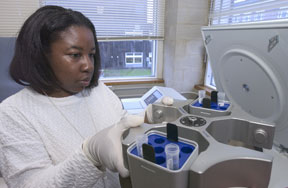 |
 |
|
 |
 |
 |
 |
 |
|
 |
 |
 |
 |
 |
|
Dr. Richardson at work in the lab.
|
|
Helping Opiate-Addicted Babies
MBL summer researcher Dr. Kimberlei Richardson is currently working to help solve a problem that some 350,000 babies are born with each year: opiate addiction. Richardson, a neuroscientist and second-year postdoctoral fellow in the Pediatrics Department at Johns Hopkins University Hospital, has seen the problem firsthand. According to Dr Richardson, "Baltimore has a high proportion of opiate-exposed infants. Some of these infants have been exposed to heroin, but a majority of infants are exposed to methadone that the mothers are given to treat the mother's addiction. Methadone is good for the mother because it stabilizes her withdrawal symptoms and ensures that she has good prenatal care. But it is a long-acting opiate and thus the infants have withdrawal symptoms after delivery."
Opiate withdrawal in infants, called neonatal abstinence syndrome, is characterized by high-pitched crying, inconsolability, increased muscle tone, tremors, vomiting, diarrhea, and, in severe cases, seizures. "The traditional treatment for reducing these symptoms in babies is a tincture of opium, a diluted form of morphine. But the optimal therapy is to treat them with an agent that's non-addictive," Richardson says.
Basic and clinical research targeting the cellular and molecular mechanisms underlying the development of opiate dependence and withdrawal in the infants are needed. So inside her MBL laboratory, Richardson is using neonatal rat models to study the role of a neurotransmitter called norepinephrine (which is released in high amounts during withdrawal) and its influence on specific brain regions believed to be associated with opiate withdrawal. "The increased release of norepinephrine is a cause of physical withdrawal symptoms," she says.
Richardson is especially interested in the effects of a norepinephrine-blocking drug called clonidine and its possible use as a treatment for opiate (both heroin and methadone) exposed infants. The drug, which is traditionally used for treating high blood pressure, has been shown to relieve withdrawal symptoms in adult humans. It is currently being used for the treatment of withdrawal symptoms in newborn infants in a randomized double-blind clinical trial by Richardson’s mentor, Dr. Estelle B. Gauda, at Johns Hopkins Hospital (the trial is supported by the National Institute on Drug Abuse and the National Institutes of Health).
"The effects of clonidine on withdrawal symptoms are documented in adults but not conclusively in infants," says Richardson, who hopes to shed light on the drug's use as a possible alternative treatment for babies undergoing withdrawal. "The goal is to extrapolate information from animal models, which will ultimately help clinicians decide which therapies are best for neonates who display opiate withdrawal symptoms," she says.
Dr. Richardson is conducting research at the MBL thanks to a fellowship from the Grass Foundation. This program provides a first opportunity for neuroscientists during late stages of predoctoral training or during postdoctoral years to conduct independent research on their own at the MBL each summer.
###
|
| |

 |
|
 |
 |
|